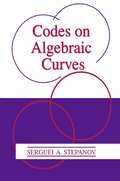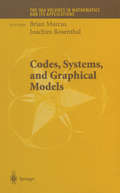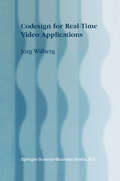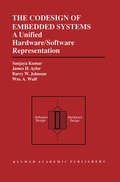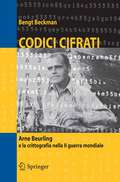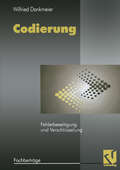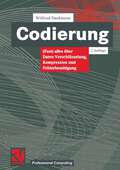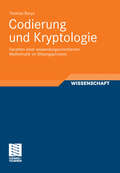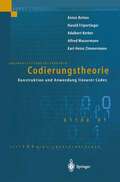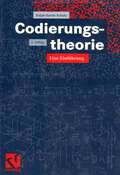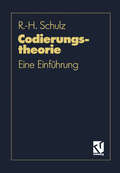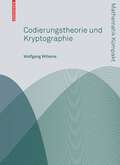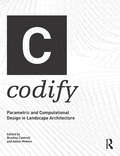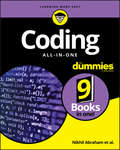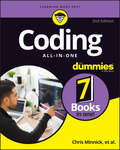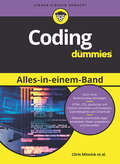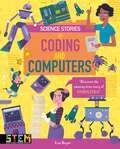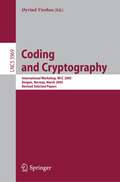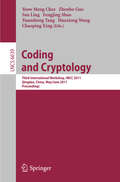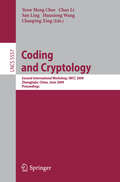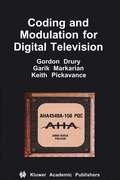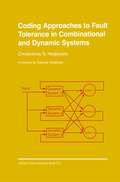- Table View
- List View
Codes on Algebraic Curves
by Serguei A. StepanovThis is a self-contained introduction to algebraic curves over finite fields and geometric Goppa codes. There are four main divisions in the book. The first is a brief exposition of basic concepts and facts of the theory of error-correcting codes (Part I). The second is a complete presentation of the theory of algebraic curves, especially the curves defined over finite fields (Part II). The third is a detailed description of the theory of classical modular curves and their reduction modulo a prime number (Part III). The fourth (and basic) is the construction of geometric Goppa codes and the production of asymptotically good linear codes coming from algebraic curves over finite fields (Part IV). The theory of geometric Goppa codes is a fascinating topic where two extremes meet: the highly abstract and deep theory of algebraic (specifically modular) curves over finite fields and the very concrete problems in the engineering of information transmission. At the present time there are two essentially different ways to produce asymptotically good codes coming from algebraic curves over a finite field with an extremely large number of rational points. The first way, developed by M. A. Tsfasman, S. G. Vladut and Th. Zink [210], is rather difficult and assumes a serious acquaintance with the theory of modular curves and their reduction modulo a prime number. The second way, proposed recently by A.
Codes, Systems, and Graphical Models (The IMA Volumes in Mathematics and its Applications #123)
by Brian Marcus Joachim RosenthalCoding theory, system theory, and symbolic dynamics have much in common. A major new theme in this area of research is that of codes and systems based on graphical models. This volume contains survey and research articles from leading researchers at the interface of these subjects.
Codesign for Real-Time Video Applications
by Jörg WilbergCodesign for Real-Time Video Applications describes a modern design approach for embedded systems. It combines the design of hardware, software, and algorithms. Traditionally, these design domains are treated separately to reduce the design complexity. Advanced design tools support a codesign of the different domains which opens an opportunity for exploiting synergetic effects. The design approach is illustrated by the design of a video compression system. It is integrated into the video card of a PC. A VLIW processor architecture is used as the basis of the compression system and popular video compression algorithms (MPEG, JPEG, H.261) are analyzed. A complete top-down design flow is presented and the design tools for each of the design steps are explained. The tools are integrated into an HTML-based design framework. The resulting design data can be directly integrated into the WWW. This is a crucial aspect for supporting distributed design groups. The design data can be directly documented an cross referencing in an almost arbitrary way is supported. This provides a platform for information sharing among the different design domains. Codesign for Real-Time Video Applications focuses on the multi-disciplinary aspects of embedded system design. It combines design automation and advanced processor design with an important application domain. A quantitative design approach is emphasized which focuses the design time on the most crucial components. Thus enabling a fast and cost efficient design methodology. This book will be of interest to researchers, designers and managers working in embedded system design.
The Codesign of Embedded Systems: A Unified Hardware/Software Representation
by Sanjaya Kumar James H. Aylor Barry W. Johnson Wm.A. WulfCurrent practice dictates the separation of the hardware and software development paths early in the design cycle. These paths remain independent with very little interaction occurring between them until system integration. In particular, hardware is often specified without fully appreciating the computational requirements of the software. Also, software development does not influence hardware development and does not track changes made during the hardware design phase. Thus, the ability to explore hardware/software tradeoffs is restricted, such as the movement of functionality from the software domain to the hardware domain (and vice-versa) or the modification of the hardware/software interface. As a result, problems that are encountered during system integration may require modification of the software and/or hardware, resulting in potentially significant cost increases and schedule overruns. To address the problems described above, a cooperative design approach, one that utilizes a unified view of hardware and software, is described. This approach is called hardware/software codesign. The Codesign of Embedded Systems develops several fundamental hardware/software codesign concepts and a methodology that supports them. A unified representation, referred to as a decomposition graph, is presented which can be used to describe hardware or software using either functional abstractions or data abstractions. Using a unified representation based on functional abstractions, an abstract hardware/software model has been implemented in a common simulation environment called ADEPT (Advanced Design Environment Prototyping Tool). This model permits early hardware/software evaluation and tradeoff exploration. Techniques have been developed which support the identification of software bottlenecks and the evaluation of design alternatives with respect to multiple metrics. The application of the model is demonstrated on several examples. A unified representation based on data abstractions is also explored. This work leads to investigations regarding the application of object-oriented techniques to hardware design. The Codesign of Embedded Systems: A Unified Hardware/Software Representation describes a novel approach to a topic of immense importance to CAD researchers and designers alike.
Codici cifrati: Arne Beurling e la crittografia nella II guerra mondiale
by Bengt BeckmanDurante la II guerra mondiale hanno avuto luogo numerosi risultati di rilievo nel campo della crittografia militare. Uno dei meno conosciuti è quello usato dal servizio di intelligence svedese, nei confronti del codice tedesco per le comunicazioni strategiche con i comandi dei paesi occupati nel nord Europa, le cui linee passavano per la Svezia. In tal modo, durante la fase più critica della guerra la direzione politica e militare svedese era in grado di seguire i piani e le disposizioni dei Tedeschi, venendo a conoscenza dei più arditi progetti per modificare la propria politica, tenendo la Svezia fuori dalla guerra. La violazione del codice tedesco è narrata in dettaglio, per la prima volta, con elementi che gli permettono di essere un’ottima introduzione al campo della crittografia, oltre che un ritratto vitale e umano della società del tempo: una disperata condizione bellica, l'intrigo politico e spionistico, il genio del matematico Arne Beurling, le difficoltà e i trucchi del mestiere, e il lavoro sistematico e oscuro di una folla di decrittatori.
Codierung: Fehlerbeseitigung und Verschlüsselung (DuD-Fachbeiträge)
by Wilfried DankmeierDiese Einführung in das Themengebiet "Codierung" richtet sich sowohl an Studenten und Programmierer wie auch an Datenschützer, die es mit Fragen der Verschlüsselung zu tun haben. Anhand von aussagekräftigen Beispielen werden aktuelle Codierungsverfahren zur Fehlererkennung, Fehlerkorrektur und Verschlüsselung vorgestellt. Besonderes Augenmerk gilt der Leistungsfähigkeit dieser Verfahren. Heute im intensiven Einsatz befindliche Verfahren wie die Fehlerbündelerkennung mit der CRC-Technik oder die Fehlerkorrektur bei CDs mit dem Reed-Solomon-Code werden unter anderem ebenso behandelt wie DES- und RSA-Verschlüsselung oder hochsichere Paßwortverfahren. Die Darstellung der mathematischen Grundlagen beschränkt sich auf das notwendigste. Allerdings erfährt der Leser, der sich hierfür besonders interessiert, eine Reihe nützlicher Détails aus dem Gebiet der endlichen Zahlenkörper.
Codierung: (Fast) alles über Daten-Verschlüsselung, Kompression und Fehlerbeseitigung (DuD-Fachbeiträge)
by Wilfried DankmeierDas Buch richtet sich an Studenten, Ingenieure, Informatiker und alle, die sich mit dem spannenden, hochaktuellen Gebiet der Codierungstechnik auseinandersetzen. Betrachtete "Objekte" sind hierbei die Daten und Informationen, die wir als Texte, Tabellen, Grafiken, Audio/Videosequenzen, Handy-Gespräche, Programme oder vielfältige Geschäftsdaten den aus PCs, Servern und Übertragungsnetzen bestehenden Informatiksystemen anvertrauen. Das Buch behandelt nahezu alle Methoden, die im "Internet-Zeitalter" von Interesse sind: Verschlüsselung, elektronische Unterschrift, Kompression von Video- und Audiodateien, Optimierung von Speicherplatz und Übertragungszeit, Beseitigung unvermeidlicher, technisch bedingter Fehler. Dahinter stecken hochmoderne und pfiffige Verfahren, die der Leser verständlich, mithin manchmal kurzweilig nahe gebracht bekommt.
Codierung und Kryptologie: Facetten einer anwendungsorientierten Mathematik im Bildungsprozess
by Thomas BorysThomas Borys untersucht aus didaktischer Sicht, welchen Beitrag die Inhalte Codierung und Kryptologie zur mathematischen bzw. informatischen Bildung leisten. Seine epistemologische Analyse erfolgt auf Basis des genetischen Prinzips und der fundamentalen Ideen der Mathematik und der Informatik, die als Leitlinien der mathematischen bzw. informatischen Bildung dienen. An ausgewählten Beispielen der Codierung und Kryptologie wird gezeigt, was bei der Umsetzung im Unterricht zu beachten ist.
Codierungstheorie: Konstruktion und Anwendung linearer Codes
by Anton Betten Harald Fripertinger Adalbert Kerber Alfred Wassermann Karl-Heinz ZimmermannDiese Einführung in die Theorie der linearen Codes behandelt besonders ausführlich zyklische Codes. Daneben liegt ein Schwerpunkt auf computerunterstützten Methoden, insbesondere für die Bestimmung der Minimaldistanz linearer Codes, für die Abzählung der Isometrieklassen linearer Codes sowie Blockcodes und für die Erzeugung von Repräsentantensystemen dieser Klassen.
Codierungstheorie: Eine Einführung
by Ralph-Hardo SchulzDas Lehrbuch über Codierungstheorie für Mathematik- und Informatik-Studenten setzt außer elementarem Grundwissen keine besonderen Kenntnisse voraus. Angesprochen werden Themen aus den Gebieten: Quellencodierung, Prüfzeichenverfahren, fehlerkorrigierende Codes und Kryptosysteme. Begriffe, Methoden und Sätze sind bis ins Detail ausführlich dargestellt und durch viele einfache Beispiele erläutert. Ergänzend zur 1. Auflage sind als Themen u.a. hinzugekommen: DVD-Datenträger, MDS-Codes und Bögen, Codes über Z4, Quantencodes, Zero-Knowledge-Protokolle, Quantenkryptographie und elliptische Kurven in der Kryptographie.
Codierungstheorie: Eine Einführung
by Ralph-Hardo SchulzDiese Einführung in die Codierungstheorie ist aus Vorlesungen für Mathematik- und Informatik-Studenten entstanden. Angesprochen werden Themen aus den Gebieten: Quellencodierung, Prüfzeichenverfahren, fehlerkorrigierende Codes und Kryptosysteme. Begriffe, Methoden und Sätze sind bis ins Detail ausführlich dargestellt und durch viele einfache Beispiele erläutert.
Codierungstheorie und Kryptographie (Mathematik Kompakt)
by Wolfgang WillemsIm heutigen Informationszeitalter werden ständig riesige Mengen digitaler Daten über verschiedene Kanäle übertragen. Codierungstheorie und Kryptographie sind Instrumente, um zentrale Probleme der Datenübertragung wie Übertragungsfehler und Datensicherheit zu lösen. Das Buch führt in die aktuellen Methoden der Codierungstheorie und Kryptographie ein und vermittelt notwendige Grundlagen der Algebra und der Algorithmen. Dabei werden LDPC-Codes und der AKS-Algorithmus ausführlich dargestellt. Der Anhang bietet zahlreiche Übungsaufgaben.
Codify: Parametric and Computational Design in Landscape Architecture
by Bradley Cantrell Adam MekiesCodify: Parametric and Computational Design in Landscape Architecture provides a series of essays that explore what it means to use, modify and create computational tools in a contemporary design environment. Landscape architecture has a long history of innovation in the areas of computation and media, particularly in how the discipline represents, analyses, and constructs complex systems. This curated volume spans academic and professional projects to form a snapshot of digital practices that aim to show how computation is a tool that goes beyond methods of representation and media. The book is organized in four sections; syntax, perception, employ, and prospective. The essays are written by leading academics and professionals and the sections examine the role of computational tools in landscape architecture through case studies, historical accounts, theoretical arguments, and nascent propositions.
Codify: Parametric and Computational Design in Landscape Architecture
by Bradley Cantrell Adam MekiesCodify: Parametric and Computational Design in Landscape Architecture provides a series of essays that explore what it means to use, modify and create computational tools in a contemporary design environment. Landscape architecture has a long history of innovation in the areas of computation and media, particularly in how the discipline represents, analyses, and constructs complex systems. This curated volume spans academic and professional projects to form a snapshot of digital practices that aim to show how computation is a tool that goes beyond methods of representation and media. The book is organized in four sections; syntax, perception, employ, and prospective. The essays are written by leading academics and professionals and the sections examine the role of computational tools in landscape architecture through case studies, historical accounts, theoretical arguments, and nascent propositions.
Coding All-in-One For Dummies
by Nikhil AbrahamSee all the things coding can accomplish The demand for people with coding know-how exceeds the number of people who understand the languages that power technology. Coding All-in-One For Dummies gives you an ideal place to start when you're ready to add this valuable asset to your professional repertoire. Whether you need to learn how coding works to build a web page or an application or see how coding drives the data revolution, this resource introduces the languages and processes you'll need to know. Peek inside to quickly learn the basics of simple web languages, then move on to start thinking like a professional coder and using languages that power big applications. Take a look inside for the steps to get started with updating a website, creating the next great mobile app, or exploring the world of data science. Whether you're looking for a complete beginner's guide or a trusted resource for when you encounter problems with coding, there's something for you! Create code for the web Get the tools to create a mobile app Discover languages that power data science See the future of coding with machine learning tools With the demand for skilled coders at an all-time high, Coding All-in-One For Dummies is here to propel coding newbies to the ranks of professional programmers.
Coding All-in-One For Dummies
by Nikhil AbrahamSee all the things coding can accomplish The demand for people with coding know-how exceeds the number of people who understand the languages that power technology. Coding All-in-One For Dummies gives you an ideal place to start when you're ready to add this valuable asset to your professional repertoire. Whether you need to learn how coding works to build a web page or an application or see how coding drives the data revolution, this resource introduces the languages and processes you'll need to know. Peek inside to quickly learn the basics of simple web languages, then move on to start thinking like a professional coder and using languages that power big applications. Take a look inside for the steps to get started with updating a website, creating the next great mobile app, or exploring the world of data science. Whether you're looking for a complete beginner's guide or a trusted resource for when you encounter problems with coding, there's something for you! Create code for the web Get the tools to create a mobile app Discover languages that power data science See the future of coding with machine learning tools With the demand for skilled coders at an all-time high, Coding All-in-One For Dummies is here to propel coding newbies to the ranks of professional programmers.
Coding All-in-One For Dummies
by Chris MinnickThe go-to guide for learning coding from the ground-up Adding some coding know-how to your skills can help launch a new career or bolster an old one. Coding All-in-One For Dummies offers an ideal starting place for learning the languages that make technology go. This edition gets you started with a helpful explanation of how coding works and how it’s applied in the real-world before setting you on a path toward writing code for web building, mobile application development, and data analysis. Add coding to your skillset for your existing career, or begin the exciting transition into life as a professional developer—Dummies makes it easy. Learn coding basics and how to apply them Analyze data and automate routine tasks on the job Get the foundation you need to launch a career as a coder Add HTML, JavaScript, and Python know-how to your resume This book serves up insight on the basics of coding, designed to be easy to follow, even if you’ve never written a line of code in your life. You can do this.
Coding All-in-One For Dummies
by Chris MinnickThe go-to guide for learning coding from the ground-up Adding some coding know-how to your skills can help launch a new career or bolster an old one. Coding All-in-One For Dummies offers an ideal starting place for learning the languages that make technology go. This edition gets you started with a helpful explanation of how coding works and how it’s applied in the real-world before setting you on a path toward writing code for web building, mobile application development, and data analysis. Add coding to your skillset for your existing career, or begin the exciting transition into life as a professional developer—Dummies makes it easy. Learn coding basics and how to apply them Analyze data and automate routine tasks on the job Get the foundation you need to launch a career as a coder Add HTML, JavaScript, and Python know-how to your resume This book serves up insight on the basics of coding, designed to be easy to follow, even if you’ve never written a line of code in your life. You can do this.
Coding Alles-in-einem-Band für Dummies (Für Dummies)
by Chris Minnick Nikhil Abraham Barry Burd Eva Holland Luca Massaron John Paul MuellerWenn Sie Webseiten oder mobile Apps entwickeln möchten, dann ist dieses Buch für Sie gemacht! Auch ganz ohne Vorkenntnisse steigen Sie einfach ein und lernen die einzelnen Programmiersprachen und Technologien jeweils für sich und im Zusammenspiel kennen und einsetzen. Angefangen beim grundlegenden Aufbau einer Webseite mit HTML, CSS und JavaScript über die Entwicklung mobiler Apps für iOS- und Android-Geräte mit Flutter bis hin zur Verarbeitung der Daten mit Python: Hier ist einfach mehr für Sie drin! Wenn Sie sich einen breiten Überblick über die Webentwicklung und Programmierung verschaffen wollen, dann werfen Sie am besten gleich einen Blick in dieses Buch ...
Coding and Computers: Discover the Amazing True Story of Computers! (Science Stories)
by Lisa ReganComputers are such an important part of our everyday lives... but how much do you really know about them? How does code work? Who invented the internet? This endlessly fascinating book not only explores the science behind information technology, but reveals the true-life stories of the people behind the scenes who played important roles in forging this radical transformation in human culture. It's absolutely packed with surprising and eye-opening facts, and a blast to read. A great gift for kids aged 8+.ABOUT THE SERIES: Science Stories is a vibrant educational series, focusing on the history of science and its major breakthroughs. Each title focuses on a different discipline - from computer science to the periodic table - brought to life by Roy Hermelin's full-colour illustrations.
Coding and Cryptography: International Workshop, WCC 2005, Bergen, Norway, March 14-18, 2005, Revised Selected Papers (Lecture Notes in Computer Science #3969)
by Øyvind YtrehusThis book constitutes the thoroughly refereed post-proceedings of the International Workshop on Coding and Cryptography, WCC 2005, held in Bergen, Norway, in March 2005. The 33 revised full papers were carefully reviewed and selected during two rounds of review. The papers address all aspects of coding theory, cryptography and related areas, theoretical or applied.
Coding and Cryptology: Third International Workshop, IWCC 2011, Qingdao, China, May 30-June 3, 2011. Proceedings (Lecture Notes in Computer Science #6639)
by Yeow Meng Chee Zhenbo Guo San Ling Fengjing Shao Yuansheng Tang Huaxiong Wang Chaoping XingThis book constitutes the refereed proceedings of the Third International Workshop on Coding and Cryptology, IWCC 2011, held in Qingdao, China, May 30-June 3, 2011. The 19 revised full technical papers are contributed by the invited speakers of the workshop. The papers were carefully reviewed and cover a broad range of foundational and methodological as well as applicative issues in coding and cryptology, as well as related areas such as combinatorics.
Coding and Cryptology: Second International Workshop, IWCC 2009 (Lecture Notes in Computer Science #5557)
by Yeow Meng Chee Chao Li San Ling Huaxiong Wang Chaoping XingThis book constitutes the refereed proceedings of the Second International Workshop on Coding and Cryptology, IWCC 2009, held in Zhangjiajie, China, in June 2009. The 21 revised full technical papers, except one, are contributed by the invited speakers of the workshop. The papers were carefully selected during two rounds of reviewing and improvement for inclusion in the volume and address all aspects of coding theory, cryptology and related areas - such as combinatorics - theoretical or applied. Topics addressed are coding theory, secure codes, hash functions, combinatorics, boolean functions, authentication, cryptography, protocols, sequences, and secure communications.
Coding and Modulation for Digital Television (Multimedia Systems and Applications #17)
by Gordon M. Drury Garik Markarian Keith PickavanceCoding and Modulation for Digital Television presents a comprehensive description of all error control coding and digital modulation techniques used in Digital Television (DTV). This book illustrates the relevant elements from the expansive theory of channel coding to how the transmission environment dictates the choice of error control coding and digital modulation schemes. These elements are presented in such a way that both the `mathematical integrity' and `understanding for engineers' are combined in a complete form and supported by a number of practical examples. In addition, the book contains descriptions of the existing standards and provides a valuable source of corresponding references. Coding and Modulation for Digital Television also features a description of the latest techniques, providing the reader with a glimpse of future digital broadcasting. These include the concepts of soft-in-soft-out decoding, turbo-coding and cross-correlated quadrature modulation, all of which will have a prominent future in improving efficiency of the next generation DTV systems. Coding and Modulation for Digital Television is essential reading for all undergraduate and postgraduate students, broadcasting and communication engineers, researchers, marketing managers, regulatory bodies, governmental organizations and standardization institutions of the digital television industry.
Coding Approaches to Fault Tolerance in Combinational and Dynamic Systems (The Springer International Series in Engineering and Computer Science #660)
by Christoforos N. HadjicostisCoding Approaches to Fault Tolerance in Combinational and Dynamic Systems describes coding approaches for designing fault-tolerant systems, i.e., systems that exhibit structured redundancy that enables them to distinguish between correct and incorrect results or between valid and invalid states. Since redundancy is expensive and counter-intuitive to the traditional notion of system design, the book focuses on resource-efficient methodologies that avoid excessive use of redundancy by exploiting the algorithmic/dynamic structure of a particular combinational or dynamic system. The first part of Coding Approaches to Fault Tolerance in Combinational and Dynamic Systems focuses on fault-tolerant combinational systems providing a review of von Neumann's classical work on Probabilistic Logics (including some more recent work on noisy gates) and describing the use of arithmetic coding and algorithm-based fault-tolerant schemes in algebraic settings. The second part of the book focuses on fault tolerance in dynamic systems. Coding Approaches to Fault Tolerance in Combinational and Dynamic Systems also discusses how, in a dynamic system setting, one can relax the traditional assumption that the error-correcting mechanism is fault-free by using distributed error correcting mechanisms. The final chapter presents a methodology for fault diagnosis in discrete event systems that are described by Petri net models; coding techniques are used to quickly detect and identify failures. From the Foreword: "Hadjicostis has significantly expanded the setting to processes occurring in more general algebraic and dynamic systems... The book responds to the growing need to handle faults in complex digital chips and complex networked systems, and to consider the effects of faults at the design stage rather than afterwards." George Verghese, Massachusetts Institute of Technology Coding Approaches to Fault Tolerance in Combinational and Dynamic Systems will be of interest to both researchers and practitioners in the area of fault tolerance, systems design and control.
